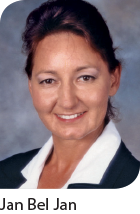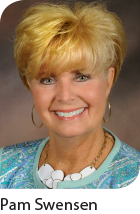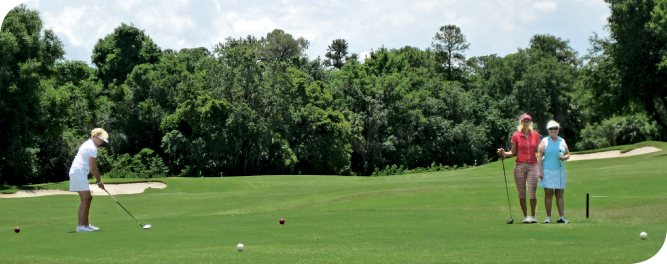5 keys to picking up women: Tips to increase rounds played by women at your golf course
Two years ago, while attending the International Network of Golf conference at Innisbrook resort in Palm Harbor, Fla., Debbie Waitkus, president of Golf For Cause, was sitting through a presentation on the USGA’s then brand new Tee It Forward campaign.
As the speaker rolled out the program that touted the benefits of moving forward in the tee box complex as golfers age, she looked through the materials, studying page by page, and noticed a glaring omission: Women had been entirely left out.
“So here we were at the ING conference. Jan Bel Jan (ASGCA, Jan Bel Jan Golf Course Design), Pam Swensen (CEO, Executive Women’s Golf Association) and I are kicking each other under the table,” Waitkus says. The group turned to one another and agreed, “We need to come together.”
A movement was born. A year later, the National Women’s Golf Alliance was a reality.
The organization was formed to offer club managers, pros and superintendents strategies on how to make their courses more attractive to women who may be daily fee players or potential club members. The group’s mission is to increase the overall health and economic viability of the game by increasing the number of women playing golf and to improve engagement levels of existing women golfers.
NWGA’s process
The NWGA visits golf courses and facilities and rates them for women-friendliness. The association developed a base of standards and best practices to help make golf facilities more welcoming and accessible to women in an effort to enhance golf’s overall appeal to women.
A team of secret shoppers visits a course and plays a round of golf, spends time in the clubhouse and takes note of the experience. To date, more than two-dozen golf courses and facilities have been evaluated on the NWGA’s five core criteria: playability, customer service, golf course amenities, facility amenities and golf programs.
The playability criteria focuses on the needs of the average female golfer. “If there are multiple sets of tees, at least one set must be under 5,000 yards, and the forward tees should all be maintained to the same standard as all the other tees,” Bel Jan says. “We look for carries, sharp dog legs, just a number of things architecturally that would help make a golf course strategically appealing but not penal to a variety of women players. “The idea is to make the game accessible, not easy,” Bel Jan says.
“Women don’t slow down the game because they’re out looking for golf balls. They’re generally in the fairway, just not hitting it as far. That’s why this criteria is so important. It’s about playability, not for the superb player, but for the bogey player or the bogey-plus player to engage in the game,” she adds. “If you can get on in regulation then you could have a terrific handicap, just playing from the proper yardage. And that’s what we’re looking for, to give women the chance to throw their hands up and make a birdie or eagle with regularity, not just five times a season.”
Service and amenities
 For the customer service criteria, NWGA evaluators pay attention to how women are treated at the facility, such as if they are welcomed and thanked for their patronage, if tee times are readily available to women and if there are any women in key staff positions.
“At one course we did an evaluation, one of the gals who does outside service handed me a card that gave me a free drink at the bar,” Waitkus says. “I could have had a bad round but they said, ‘We’re so glad you came out today.’ That was my last touch point and I walked away with a good feeling.”
For the customer service criteria, NWGA evaluators pay attention to how women are treated at the facility, such as if they are welcomed and thanked for their patronage, if tee times are readily available to women and if there are any women in key staff positions.
“At one course we did an evaluation, one of the gals who does outside service handed me a card that gave me a free drink at the bar,” Waitkus says. “I could have had a bad round but they said, ‘We’re so glad you came out today.’ That was my last touch point and I walked away with a good feeling.”
[ RELATED: 5 key criteria evaluated for NWGA Certification | Shouldn’t ladies lead the way to golf growth? ]
According to the criteria, on-course amenities such as ball washers and drinking water stations should be conveniently located to the forward tees and placed in areas that are safe to access. Clean restrooms on the course are considered important, as well. Facility amenities should also be appealing to women. Offering healthful food, not just burgers and brats, and a selection of women’s apparel and equipment in the pro shop, reflects postively toward certification. Women-specific golf programs, such as ladies-only events and instruction, are a big plus as well.
Scorecard
After the NWGA visit, a detailed report is delivered to club management. The report doesn’t just point out flaws and areas that need improvement, Bel Jan says, it also “sees all of the things they are doing right and applauds the good news.”
Two to six months after the initial site visit, the NWGA visits again, playing a round of golf and completing a follow-up report. It records any changes based on the prior report’s recommendations or improvements according to the established criteria.
Golf facilities must achieve an 80 percent score in at least three of the core criteria to be deemed certified by the NWGA. Facilities are certified for three years. Courses can enter the certification program for a fee of $500 per year and two rounds of golf for a foursome to conduct the evaluation, Bel Jan says.
Moreover, some of the recommended changes don’t cost a thing. “Teaching staff to say thank you doesn’t cost a cent,” Waitkus says. Other changes, such as constructing additional tee boxes, may take more time and require some expenditures, Bel Jan adds.
Rounds played
The overall goal is to help golf facilities increase their numbers of women golfers. For facilities needing additional help, the NWGA offers consulting, staff training and course design, among other services. Innisbrook, (the place where the seed for the NWGA was planted), has undergone the process and displays the NWGA Rolling Out the Green Carpet certification logo on its website.
 “We are very impressed with the wealth of information and depth of the NWGA’s course evaluations. The report was extremely comprehensive and provided valuable insight on how we can better serve women golfers, especially in addressing how to improve golf course playability,” says Rodney Green, Innisbrook’s director of golf. “The female golfer has always been an important market for us. It’s an honor to receive this certification and we enjoy striving to be a leader in golf in this regard and others.”
“We are very impressed with the wealth of information and depth of the NWGA’s course evaluations. The report was extremely comprehensive and provided valuable insight on how we can better serve women golfers, especially in addressing how to improve golf course playability,” says Rodney Green, Innisbrook’s director of golf. “The female golfer has always been an important market for us. It’s an honor to receive this certification and we enjoy striving to be a leader in golf in this regard and others.”

Jason Brill, head pro at Starfire GC in Scottsdale, Ariz., says some of the NWGA’s recommendations came as a surprise. “I wouldn’t have thought carries were as big an issue as they were.” Photo: Stacie Zinn Roberts
Starfire Golf Club in Scottsdale, Ariz., was the first golf facility to go through the NWGA certification process. Head Golf Professional Jason Brill says Starfire valued its first report from the NWGA and implemented the recommended changes immediately. The clubhouse’s Scottsdale Grill tweaked its menu to add more salads and light granola bars. In the golf shop, rental clubs for ladies—right-handed and left-handed sets—were added. As for the on-course bathrooms, fans were changed out and mirrors were framed in as part of making the overall appearance of the restrooms cleaner and more presentable. Plans also are in the works to convert a par 3 hole to a par 4 for the addition of drop areas for ladies and for the construction of two new tee boxes.
“The ladies rental clubs, that really surprised me. It’s something I wouldn’t think of, and how important the outside bathrooms are on the course. I also wouldn’t have thought the carries were as big an issue as they were,” Brill says. Since working with the NWGA evaluators, Brill says, the needs of the woman player are now “one more factor that we look into when we make decisions.”
Once entirely implemented, the changes to the facility will cost about $5,000, Brill estimates, and says the club plans to measure how many women players come through the facility on a daily basis versus before the changes were made. Already, the club’s Ladies League has been “very receptive to the changes,” he says.
 Sandy Cross is the Director of Women’s and New Market Initiatives for the PGA of America. The organization’s four courses and learning center at PGA Village in Port St. Lucie, Fla., are in the midst of evaluations under the NWGA program.
Sandy Cross is the Director of Women’s and New Market Initiatives for the PGA of America. The organization’s four courses and learning center at PGA Village in Port St. Lucie, Fla., are in the midst of evaluations under the NWGA program.
“As the PGA of America, representing 27,000 PGA Professionals managing 10,000 golf facilities around America, we know it’s important for us to set this example at our owned and operated properties,” Cross says. “We all know the economic purchasing power of women. If we are going to legitimately attract and retain women players in our sport, we have to have the facilities and the course setups that respond to her value set.”
Deep pockets
Statistics provided by the Executive Women’s Golf Association show just under 6 million women are golfers. New women golfers spend, on average, $2,000 per year at golf facilities on greens fees, lessons and food and beverage. More experienced women golfers will spend more than $4,000 on golf and golf travel. Swensen says EWGA members contribute $70 million in revenue to the US golf industry, with the average local EWGA chapter (there are 125 chapters around the country) spending about $500,000 per year on golf-related purchases in their community.
In an industry that has experienced a decrease in golf rounds and revenue, it makes sense to court the female golf customer. The NWGA certification program offers a methodology to do just that.
“It’s been a great experience. I found the NWGA evaluators to be professional, to provide very thorough results. It’s a really authentic, legitimate process to go through. It’s been very insightful and it leaves you with results in hand that provide a road map for going forward, a list of things you can do to improve your score and take it to the next level,” Cross says. “I’m confident every golf facility would benefit from going through the process.”
Stacie Zinn Roberts is a winner of multiple TOCA awards and is a frequent contributor to Golfdom. She lives in Mount Vernon, Wash.










